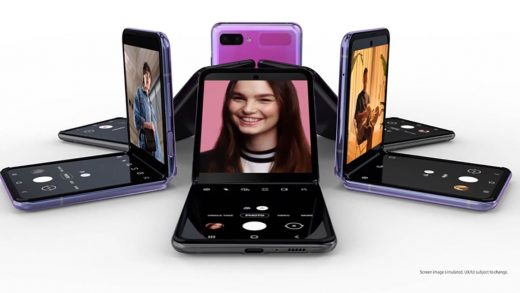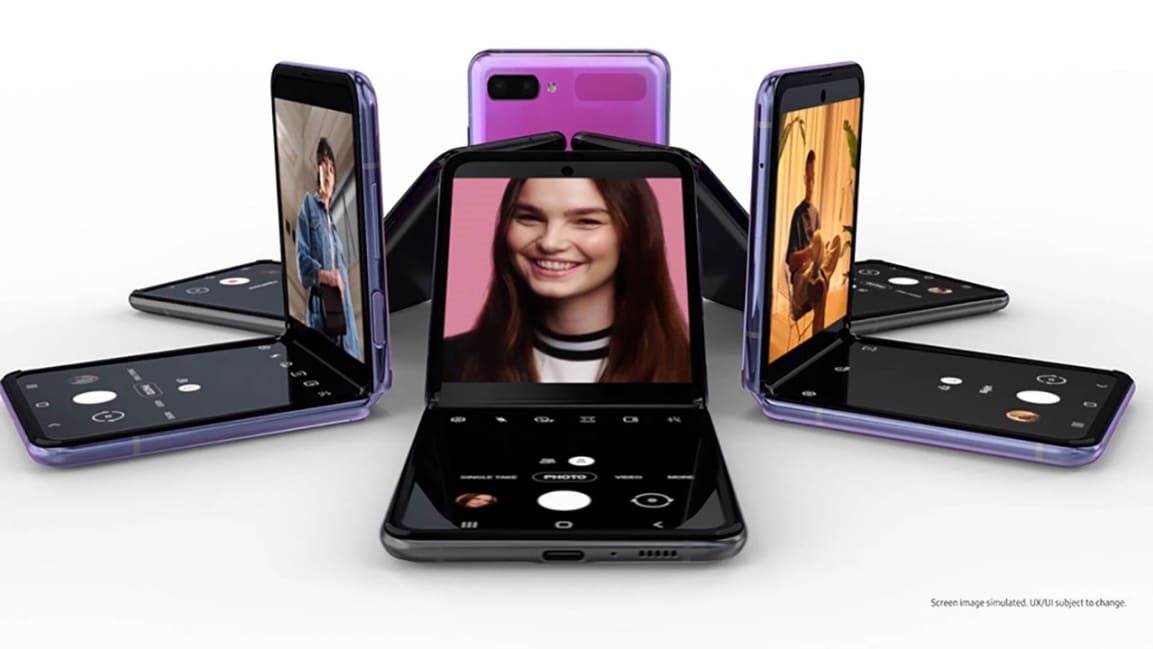Samsung’s Galaxy Z Flip folding phone: Your questions, my answers
When Samsung unveiled its Galaxy Z Flip folding phone in mid-February, it was upfront about the target audience: people who like to attract attention. And when I borrowed one from the company to try for myself, it took only 90 seconds for the Flip to live up to that aspiration. I’d just casually unfolded it for the first time in public on a busy San Francisco sidewalk when two passers-by rushed over to ask me about it.
“Is that the new Motorola?” one of them asked.
He’d mistaken the Samsung for the new foldable $1,500 Razr—introduced shortly before the $1,380 Flip, and its closest rival. But still.
On Twitter, I shared a photo of the Galaxy Z Flip—which I borrowed from Samsung and tried for a little over 24 hours—and asked folks what they wanted to know about it. Here, too, the device inspired curiosity, and so many good questions that I’m going to devote most of the rest of this story to answering them. Shall we?
Does it provide any kind of functional advantage over a normal slab?
— Edmund O’Neill (@esoneill) February 14, 2020
The folding screen on last year’s Samsung Galaxy Fold had a clear purpose—it let you store a tablet-size device in a pocket or purse. The purpose of the Galaxy Z Flip isn’t as straightforward, since folding up the phone doesn’t make it radically more portable than a comparable conventional phone. Still, the foldable 6.7? display has its virtues in some situations—though I can’t imagine many people will find them worth a $1,380 investment when excellent non-folding smartphones are so much cheaper.
At Samsung’s launch event, it played up hands-free selfies and no-tripod hyperlapse video photography as pluses. But while you can indeed plop the half-folded phone on a flat surface and snap a self-portrait using the timer or Samsung’s Bixby voice assistant, snapping selfies from a table or desk is going to result in some unflattering camera angles unless you crouch. You’d also be lucky to have an appropriate flat surface available for hyperlapse shooting.
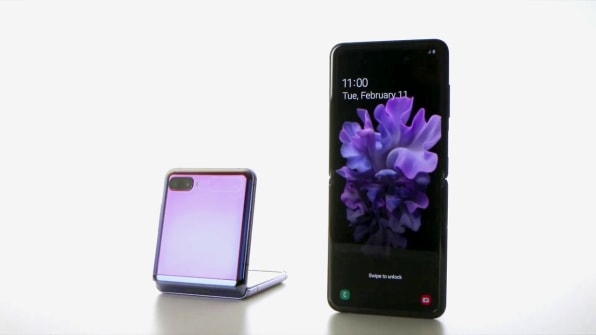
[Photo courtesy of Samsung]
When closed, the Galaxy Z Flip provides access to some features via a tiny color OLED touch strip near the camera. You can see some notifications and control music playback, for instance. It made me wonder if this severely reduced-functionality mode might appeal to people who are trying to reduce their screen time.
My 24 hours with the phone weren’t enough to form an opinion on that, but I did notice that the alert for Duo video calls comes and goes so quickly that I only saw it when I was already looking at the screen. I also wished that Google Maps notifications appeared on it, so I could get walking directions without opening the phone. And I found using the closed phone for selfies—with my image appearing on a microscopic display with an inappropriate aspect ratio—to be more bizarre than useful.
I did have fun using the phone as a miniature wide-screen TV that stands up by itself—a use-case scenario Samsung may not have had in mind:
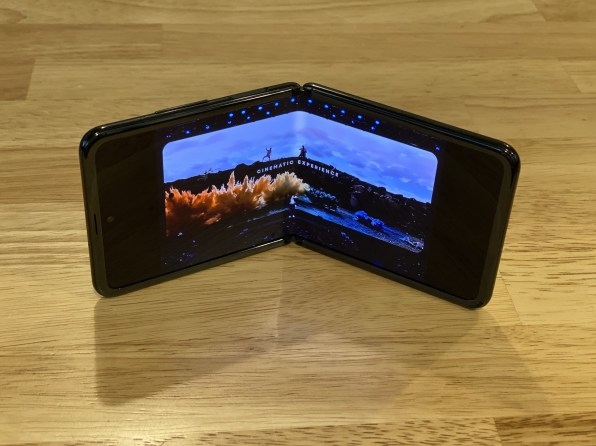
More thoughts on the value of foldability in response to this next question.
Do many apps meaningfully support different information in the half folded config
— darrenoakey (@darrenoakey) February 14, 2020
No, but there are glimmers of potential in the few that do. When you hold the phone with the top half of the screen flipped up, Samsung’s camera app switches into a mode where the upright section of screen serves as a viewfinder and the shutter button and other controls are on the horizontal portion. For one-handed photography, it’s an unexpectedly comfy alternative to grasping a typical smartphone like a Hershey bar.
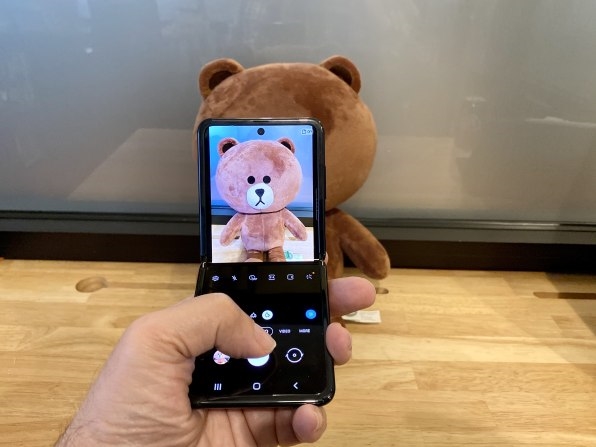
In half-folded mode, Google’s Duo video-calling app similarly puts the incoming video on the upright part of the screen; sitting on a table, the Flip becomes a nifty little desktop video phone. Oddly, though, Duo doesn’t always adjust itself to acknowledge this mode; for instance, the video window spills over onto the bottom half of the screen until a call is in progress.
If Samsung convinces scads of third-party developers to rethink their products for the Flip’s folding screen, it could be fun. But I wouldn’t buy it under the assumption that will happen. At its launch event, the company seemed to suggest that YouTube took advantage of half-fold mode, but there was nothing special about that app when I tried it.

Does it feel like a “regular” phone when fully open and once open, does it stay open?
— John Mendelson (@john_mendelson) February 14, 2020
Depending on the lighting environment and angle I held the phone at, the crease in the middle of the screen at the hinge varied from pretty much invisible to totally obvious. And my fingertip detected the crease every time I swiped past it, like a tiny dip in the road. But I wouldn’t consider any of this a major argument against buying a Galaxy Z Flip. Just as an iPhone’s notch turned out not to be an impediment in real-world use, I forgot about the Galaxy Z Flip’s telltale signs of foldability when I was using it.
Once I opened the phone, I found that it stayed unfolded until I was ready to close it back up—even if I vigorously whipped it back and forth.
In everyday use, how fragile is the phone? Could you throw it in a front pocket, and treat it like any other phone? When you get a call, does it automatically answer when you open it?
— Justin Davenport (@jad_va) February 14, 2020
Folded up, it feels quite sturdy. The main screen is concealed on the inside, it’s protected from rogue car keys and other threats. Except for temporarily storing it in a shirt pocket while I’m at my desk, I wouldn’t transport an unfolded Flip on my person any more than I would stow an open laptop in a piece of luggage.
As for automatically answering a call when you open the phone, that’s not the default. But you can turn it on, via an option buried in the accessibility settings.
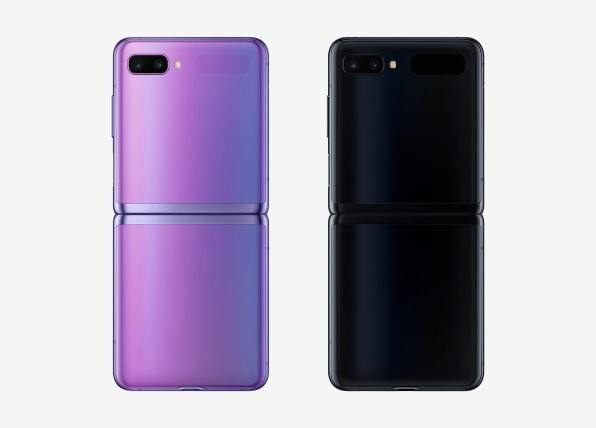
Can you open and close with one hand?
— Mark Stout (@MarkAStout) February 14, 2020
No. Or at least I couldn’t with enough ease to make the maneuver worthwhile. It’s also a two-fisted device when open, since its taller-than-usual aspect ratio leaves vast expanses of screen inaccessible to the thumb of the hand you’re using to hold the phone.
Basically, Samsung didn’t try to create a phone that evoked the flip phones of yore nearly as much as the new Motorola Razr does, right down to its revival of an early-aughts brand. Which is fine by me.
Any bubbles on the screen?
— Iain Thomson (@iainthomson) February 14, 2020
I didn’t see any. Neither did I encounter any other folding-screen-related oddities such as the folding Razr’s creaky hinge. But given the screen issues with previous folding phones—such as the Galaxy Fold and Razr—I’d want to hear from people who used the phone for extended periods before concluding that the Flip was worry-free.
If you ran your fingernail on it, would it scratch the screen?
— Ernie Smith (@ShortFormErnie) February 14, 2020
I didn’t try, because the Flip comes with a list of things to avoid doing that mentions just that. Other risky business in the list: folding the phone up with coins or keys trapped in the middle or exposing it to “liquids or small particles” (Unlike current standard-issue flagship phones, it isn’t water- or dust-resistant).
Here’s a report that says the Flip’s screen—which is thin folding glass under a plastic layer—can indeed be scratched with a fingernail. Clearly, we need something more akin to bendable Gorilla Glass—and Corning is working on it.
Filtering the “why?” questions, is it competitive as for battery, memory and performance?
— Pierpaolo Basso (@Mediaonweb) February 14, 2020
In my brief time with the Galaxy Z Flip, I didn’t gauge its battery life or come to serious conclusions about performance other than that it felt zippy. Judging from its specs, it should be somewhere in the general vicinity of last year’s Galaxy S10. That’s an advance on the Razr, which is a tad underpowered by current standards.
Does it have NFC, and if so, presumably needs to be flipped open and biometric security passed before using something like Samsung Pay or Google Pay.
— Steven Gray (@steventgray) February 14, 2020
The Galaxy Z Flip does indeed have NFC and—when open—supports Samsung Pay and Google Pay like any other Galaxy phone. I liked the idea of tapping a folded Flip against a payment terminal to pay. But even when I did so with my thumb on the fingerprint scanner, it didn’t work.
Can you compare the thickness of the Galaxy Z when closed and open compared to iPhone?
— Ryan Clough (@hotF1X) February 14, 2020
Unfolded, the Galaxy Z Flip is 7.2 mm thick at the hinge and a little skinnier elsewhere—meaningfully thinner than the 8.1 mm iPhone 11. It weighs 6.5 oz., which makes it lighter than all three of Apple’s current iPhones—the 11, 11 Pro, and 11 Pro Max. Given the need for a hinge, getting the Flip’s weight down was a slick feat of engineering: by contrast, the folding Razr is 7.23 oz., which was heavy enough to bother my colleague Mark Wilson.
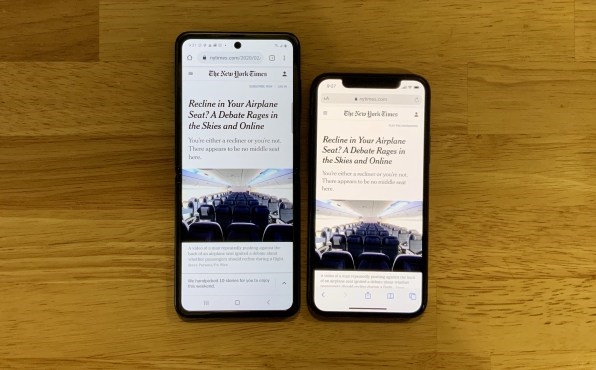
Folded up, the Flip is, logically enough, twice as thick as a thin smartphone—17.3mm at the hinge, to be exact. When I stuck it in my shirt pocket, the seams bulged more than they would with a garden-variety phone would. But at least the phone didn’t peek over the top.
Let’s wrap up with a few questions I didn’t get on Twitter, and my answers:
How are the cameras? Though I got some nice photos from the Flip, its cameras aren’t at parity with those on last year’s Galaxy S10 phones let alone the even more advanced ones on the soon-to-be-released Galaxy S20 models. I missed the 2X optical zoom and dual-aperture lenses on other Galaxy models.
Here are a couple of the photos I took:
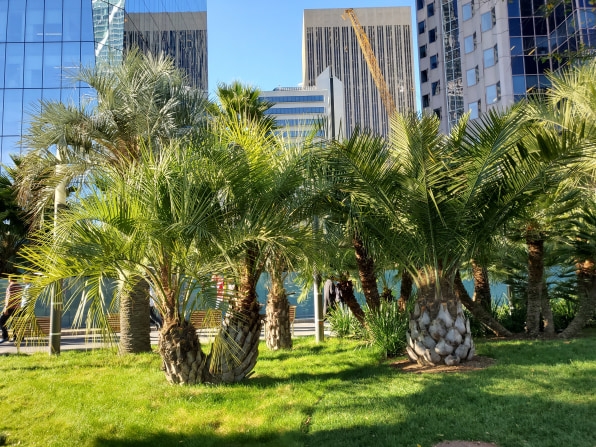
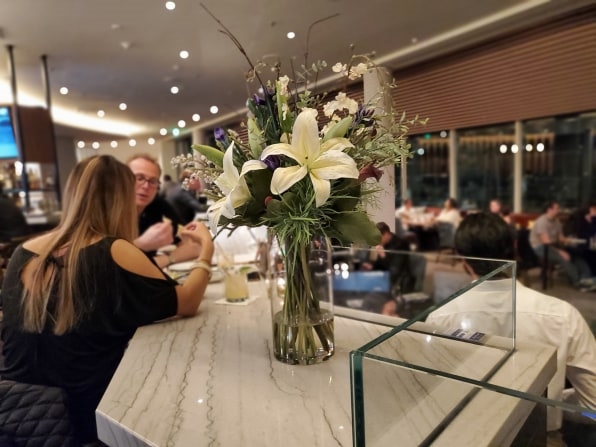
What about the fingerprint scanner? As with the Galaxy Fold, Samsung put it on the side of the case on the power button. When I carefully placed my thumb on it, it swiftly unlocked the phone—but it proved a challenge to quickly find it when looking at the screen head-on. And Samsung’s facial identification feature—which is nowhere near as smooth and reliable as Apple’s Face ID—isn’t a satisfying alternative.
Anything else? Though the Flip comes with a quick-start guide, it doesn’t address any of the features that make this phone interesting—some of which, such as the ability to control it via the external touch screen, aren’t all that obvious. You can download a more comprehensive manual, but a device as new as the Flip could use more in-the-box explanation.
Overall conclusions? Judged as a conventional smartphone, the Galaxy Z Flip is good, though hardly state of the art—especially in comparison with Samsung’s 5G-ready Galaxy S20 models, which are due to arrive next month. The fact that it folds up gives it a wow factor, is always entertaining and somewhat useful in certain circumstances, and doesn’t seem to impinge on its overall usability. (That’s a change from the Galaxy Fold, which is tough to use as a camera phone regardless of whether you’re using it in folded or unfolded mode.)
It’s impossible to judge the Galaxy Z Flip without coming back to its $1,380 price tag. Except for that unfolding 6.7? screen, the Flip is in many ways roughly comparable to the 256GB version of Samsung’s Galaxy S10e, which now sells for $540. Unless you have an unlimited gadget budget—and an overpowering desire to own a new toy before almost anybody else—the $800 premium is just too gigantic to contemplate.
Still, this phone doesn’t feel like a dead end. If Samsung keeps plugging away at building software features that take advantage of the folding screen, and the cost of display technology descends from the stratosphere, a future version could be a practical rival to today’s unbendables. Which means the day could come when the Galaxy Flip isn’t for just show-offs but the rest of us, too.
(28)

